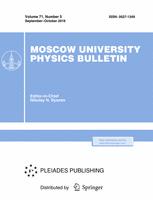The equilibrium angular orientation of a torsion pendulum suspended by a thin tungsten wire changes with time. Examining the statistics of such changes over the period of oscillations showed that for low stresses in the wire (less than 60-70% of the breaking stress), the distribution of these values is close to the Gaussian distribution. For high stresses, this distribution differs from a Gaussian one by the presence of rare comparatively large jumps of the rotation angle. They can be considered as a manifestation of strain jumps in solids caused by the dislocation motion. In mechanical systems, strain jumps cause an excess noise, which can make a substantial contribution to fluctuations in the arrangement of test masses of laser gravitational antennas.
Department of Molecular Physics and Physical Measurements, Faculty of Physics, Moscow State University, Leninskie Gory, Moscow, 119992, Russia



